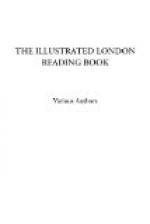It is now generally known that the Owl renders the farmer important service, by ridding him of vermin, which might otherwise consume the produce of his field; but in almost every age and country it has been regarded as a bird of ill omen, and sometimes even as the herald of death. In France, the cry or hoot is considered as a certain forerunner of misfortune to the hearer. In Tartary, the owl is looked upon in another light, though not valued as it ought to be for its useful destruction of moles, rats, and mice. The natives pay it great respect, because they attribute to this bird the preservation of the founder of their empire, Genghis Khan. That Prince, with his army, happened to be surprised and put to flight by his enemies, and was forced to conceal himself in a little coppice. An owl settled on the bush under which he was hid, and his pursuers did not search there, as they thought it impossible the bird would perch on a place where any man was concealed. Thenceforth his countrymen held the owl to be a sacred bird, and every one wore a plume of its feathers on his head.
One of the smallest of the owl tribe utters but one melancholy note now and then. The Indians in North America whistle whenever they chance to hear the solitary note; and if the bird does not very soon repeat his harmless cry, the speedy death of the superstitious hearer is foreboded. It is hence called the death bird. The voices of all carnivorous birds and beasts are harsh, and at times hideous; and probably, like that of the owl, which, from the width and capacity of its throat, is in some varieties very powerful, may be intended as an alarm and warning to the birds and animals on which they prey, to secure themselves from the approach of their stealthy foe.
Owls are divided into two groups or families—one having two tufts of feathers on the head, which have been called ears or horns, and are moveable at pleasure, the others having smooth round heads without tufts. The bills are hooked in both. There are upwards of sixty species of owls widely spread over almost every part of the known world; of these we may count not fewer than eight as more or less frequenting this country. One of the largest of the tribe is the eagle hawk, or great horned owl, the great thickness of whose plumage makes it appear nearly as large as the eagle. Some fine preserved specimens of this noble-looking bird may be seen in the British Museum. It is a most powerful bird; and a specimen was captured, with great difficulty, in 1837, when it alighted upon the mast-head of a vessel off Flamborough-head.
The amiable naturalist, Mr. Waterton, who took especial interest in the habits of the owl, writes thus on the barn owl:—“This pretty aerial wanderer of the night often comes into my room, and, after flitting to and fro, on wing so soft and silent that he is scarcely heard, takes his departure from the same window at which he had entered. I own I have a great liking for the bird; and I have offered it hospitality and protection on account of its persecutions, and for its many services to me; I wish that any little thing I could write or say might cause it to stand better with the world than it has hitherto done.”




